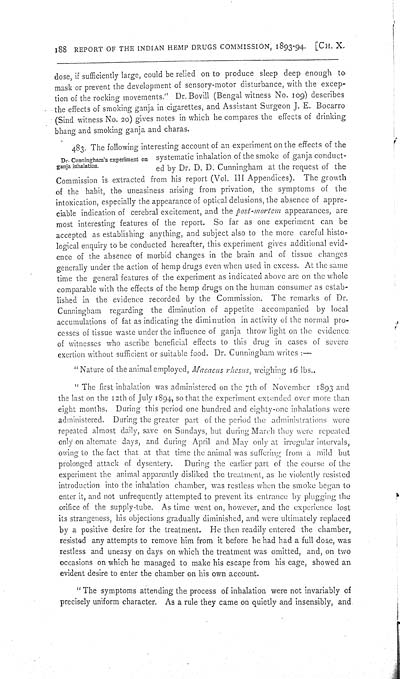Medicine - Drugs > Report of the Indian Hemp Drugs Commission, 1894-1895 > Volume I
(219) Page 188
Download files
Individual page:
Thumbnail gallery: Grid view | List view

188 REPORT OF THE INDIAN HEMP DRUGS COMMISSION, 1893-94. [CH. X.
dose, if sufficiently
large, could be relied on to produce sleep deep enough to
mask or prevent the development of sensory-motor disturbance, with
the excep-
tion of the rocking movements." Dr. Bovill (Bengal witness No. 109)
describes
the effects of smoking ganja in cigarettes, and Assistant Surgeon
J. E. Bocarro
(Sind witness No. 20) gives notes in which he compares the effects
of drinking
bhang and smoking ganja and charas.
Dr. Cunningham's
experiment on
ganja inhalation.
483. The following
interesting account of an experiment on the effects of
the
systematic inhalation of the
smoke of ganja conduct-
ed by Dr. D. D. Cunningham at the request of the
Commission is extracted from his report (Vol. III Appendices). The
growth
of the habit, the uneasiness arising from privation, the symptoms
of the
intoxication, especially the appearance of optical delusions, the
absence of appre-
ciable indication of cerebral excitement, and the
post-mortem appearances, are
most interesting features of the report. So far as one experiment
can be
accepted as establishing anything, and subject also to the more
careful histo-
logical enquiry to be conducted hereafter, this experiment gives
additional evid-
ence of the absence of morbid changes in the brain and of tissue
changes
generally under the action of hemp drugs even when used in excess.
At the same
time the general features of the experiment as indicated above are
on the whole
comparable with the effects of the hemp drugs on the human consumer
as estab-
lished in the evidence recorded by the Commission. The remarks of
Dr.
Cunningham regarding the diminution of appetite accompanied by
local
accumulations of fat as indicating the diminution in activity of
the normal pro-
cesses of tissue waste under the influence of ganja throw light on
the evidence
of witnesses who ascribe beneficial effects to this drug in cases
of severe
exertion without sufficient or suitable food. Dr. Cunningham
writes:—
"Nature of the animal employed, Macacus rhesus, weighing 16 lbs..
"The first inhalation was
administered on the 7th of November 1893 and
the last on the 12th of July 1894, so that the experiment extended
over more than
eight months. During this period one hundred and eighty-one
inhalations were
administered. During the greater part of the period the
administrations were
repeated almost daily, save on Sundays, but during March they were
repeated
only on alternate days, and during April and May only at irregular
intervals,
owing to the fact that at that time the animal was suffering from a
mild but
prolonged attack of dysentery. During the earlier part of the
course of the
experiment the animal apparently disliked the treatment, as he
violently resisted
introduction into the inhalation chamber, was restless when the
smoke began to
enter it, and not unfrequently attempted to prevent its entrance by
plugging the
orifice of the supply-tube. As time went on, however, and the
experience lost
its strangeness, his objections gradually diminished, and were
ultimately replaced
by a positive desire for the treatment. He then readily entered the
chamber,
resisted any attempts to remove him from it before he had had a
full dose, was
restless and uneasy on days on which the treatment was omitted,
and, on two
occasions on which he managed to make his escape from his eage,
showed an
evident desire to enter the chamber on his own account.
"The symptoms attending
the process of inhalation were not invariably of
precisely uniform character. As a rule they came on quietly and
insensibly, and
Set display mode to: Large image | Zoom image | Transcription
Images and transcriptions on this page, including medium image downloads, may be used under the Creative Commons Attribution 4.0 International Licence unless otherwise stated. ![]()
| India Papers > Medicine - Drugs > Report of the Indian Hemp Drugs Commission, 1894-1895 > Volume I > (219) Page 188 |
|---|
| Permanent URL | https://digital.nls.uk/74574504 |
|---|---|
| Description | Chapter X, cont. |
| Description | [Volume 1]: Report. |
|---|---|
| Attribution and copyright: |
|




